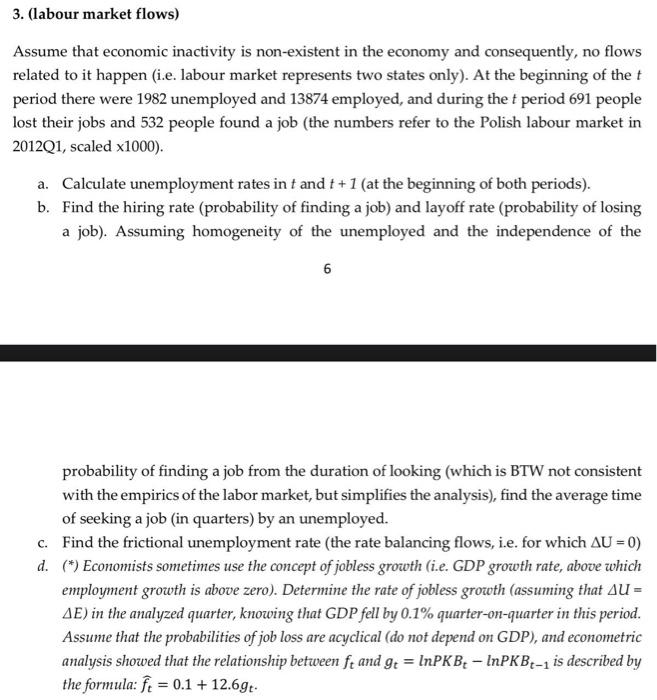3. (labour market flows) Assume that economic inactivity is non-existent in the economy and consequently, no flows related to it happen (i.e. labour market represents two states only). At the beginning of the t period there were 1982 unemployed and 13874 employed, and during the t period 691 people lost their jobs and 532 people found a job (the numbers refer to the Polish labour market in 2012Q1, scaled x1000). a. Calculate unemployment rates in t and t+1 (at the beginning of both periods). b. Find the hiring rate (probability of finding a job) and layoff rate (probability of losing a job). Assuming homogeneity of the unemployed and the independence of the 6 probability of finding a job from the duration of looking (which is BTW not consistent with the empirics of the labor market, but simplifies the analysis), find the average time of seeking a job (in quarters) by an unemployed. c. Find the frictional unemployment rate (the rate balancing flows, i.e. for which U=0 ) d. (*) Economists sometimes use the concept of jobless growth (i.e. GDP growth rate, above which employment growth is above zero). Determine the rate of jobless growth (assuming that U= E ) in the analyzed quarter, knowing that GDP fell by 0.1% quarter-on-quarter in this period. Assume that the probabilities of job loss are acyclical (do not depend on GDP), and econometric analysis showed that the relationship between ft and gt=lnPKBtlnPKBt1 is described by the formula: ft=0.1+12.6gt. 3. (labour market flows) Assume that economic inactivity is non-existent in the economy and consequently, no flows related to it happen (i.e. labour market represents two states only). At the beginning of the t period there were 1982 unemployed and 13874 employed, and during the t period 691 people lost their jobs and 532 people found a job (the numbers refer to the Polish labour market in 2012Q1, scaled x1000). a. Calculate unemployment rates in t and t+1 (at the beginning of both periods). b. Find the hiring rate (probability of finding a job) and layoff rate (probability of losing a job). Assuming homogeneity of the unemployed and the independence of the 6 probability of finding a job from the duration of looking (which is BTW not consistent with the empirics of the labor market, but simplifies the analysis), find the average time of seeking a job (in quarters) by an unemployed. c. Find the frictional unemployment rate (the rate balancing flows, i.e. for which U=0 ) d. (*) Economists sometimes use the concept of jobless growth (i.e. GDP growth rate, above which employment growth is above zero). Determine the rate of jobless growth (assuming that U= E ) in the analyzed quarter, knowing that GDP fell by 0.1% quarter-on-quarter in this period. Assume that the probabilities of job loss are acyclical (do not depend on GDP), and econometric analysis showed that the relationship between ft and gt=lnPKBtlnPKBt1 is described by the formula: ft=0.1+12.6gt







